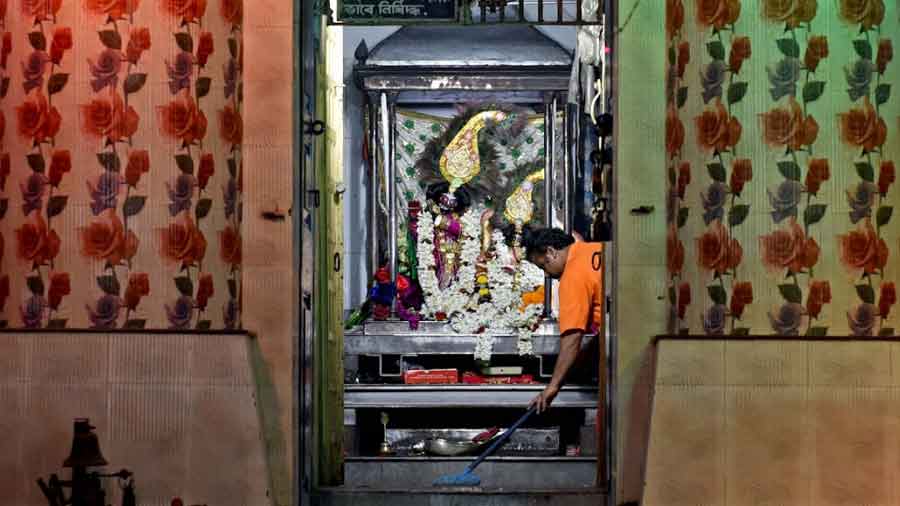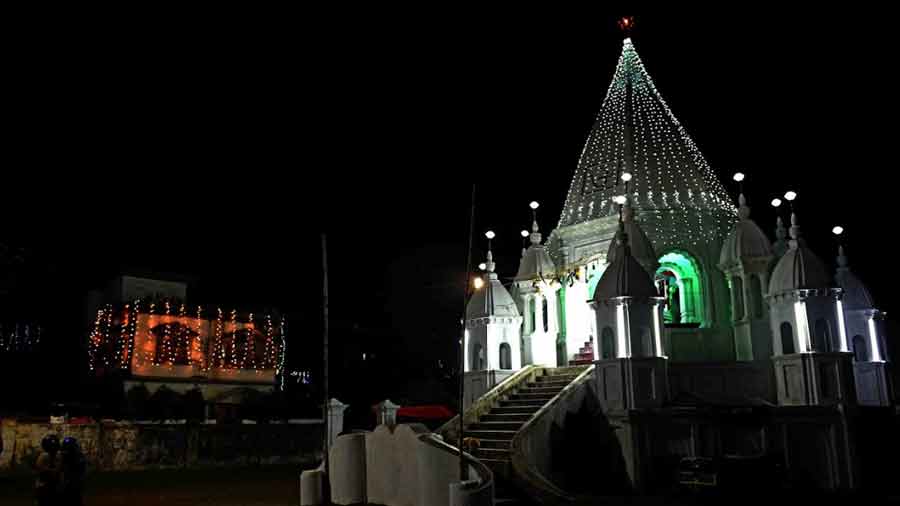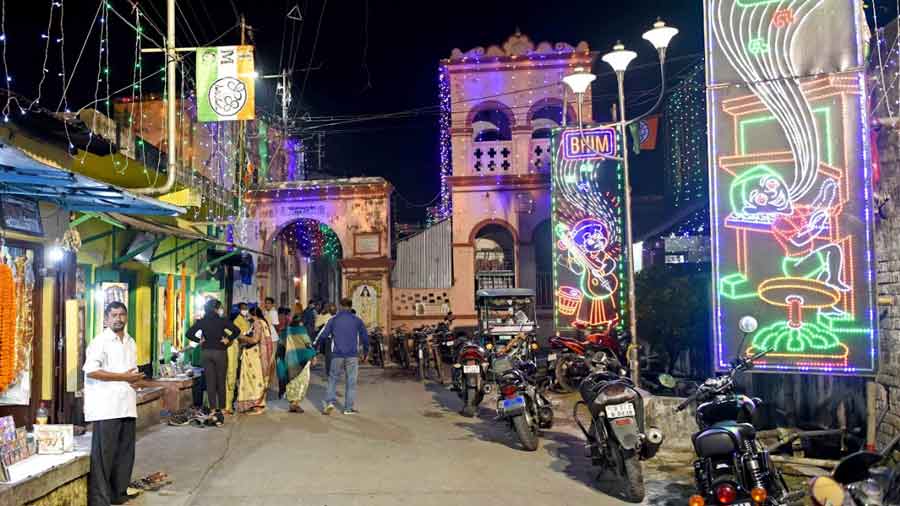On the banks of the Ganga is Khardah, a small town in North 24 Parganas under Barrackpore subdivision. Khardah is known for housing many beautiful temples, among which the beautiful aatchala (eight-roofed) Shyamsundar Jiu Mandir needs special mention. The town has also seen the footfall of many eminent personalities like Sri Ramakrishna, Rabindranath Tagore, Sister Nivedita and many more.
The place has been a home for Vaishnavites. Sri Nityananda, after getting married to Vasuda and Jahnava Devi, started residing here in the house of Purandhar Pandit (a devotee of Nityananda). After Purandhar Pandit left his abode, Nityananda settled here.
The house is surrounded with many different plants and hence named ‘Kunjobati’. It was in this house where Nityananda’s son Virbhadra Goswami was born. The idol of Shyamsundar (Krishna) was installed by Virbhadra in this house.

The Krishna and Radha idols inside the temple Amit Datta
Later, a new mandir, which houses the deity till date, was established, as told by Tapash Mukherjee, a resident of Khardah and a chronicler of the town’s history. The deity of Shyamsundar is made of a particular type of stone, called ‘kashti pathar’ in Bengali.
There are three deities of Lord Krishna made from one stone and installed in three different places. One is at the Radhaballab Jiu Mandir of Serampore, another at Nandadulal Jiu Mandir at Saibon and the third at Shyamsundar Jiu Mandir at Khardah.

The ‘Rashmancha’ on Kartik Purnima night Amit Datta
Initially, the Shyamsundar Mandir only had the idol of Krishna. Nityananda’s wife Jahnava Devi installed the Radha idol, which is made from eight metals or ‘Ashtadhatu’.
Every year on Kartik Purnima, which falls in November, a Rash Utsav is celebrated with much grandeur in Khardah. This year, it started on November 19. It’s a festival celebrating the love of Krishna for his divine consort, Radha.

The locality in brightly illuminated during the festival Amit Datta
Though the main festival lasts three days, a month-long fair is also organised on this occasion. There is a beautiful octagonal white ‘Rashmancha’ located in an open space on the banks of the Ganga known as Rashkhola Ghat.
The Rashyatra that commences on purnima continues here for three days. The deity is dressed up in three different attires and is taken from the mandir to the Rashmancha in a ‘choturdola’, a kind of palanquin.

Devotees gather inside the temple premises in the evening Amit Datta
On the first day, the deity is dressed up in ‘Notobor besh’, the second day in ‘Raj besh’ adorned with a lot of jewellery and on the last day, the deity dresses up in ‘Rakhal besh’. A huge procession is organised by the devotees with sparkling lights, music and kirtan, which plays a very important role in the festival.
Every evening, the deities are taken from the mandir to the Rashmancha and brought back early morning the next day in a palanquin. On the last day, the deities are not brought back to the mandir, but are kept in the Rashmandir till noon. Devotees queue up for darshan and puja. The deities are then brought back to the mandir accompanied by a procession.

The deities being taken for Rashyatra by the purohits Amit Datta
On the way back, the deities make door-to-door visits to the local houses and the people offer puja and bhog. This is known as ‘Goshthoyatra’. After it reaches the Shyamsundar Mandir, a huge bronze dekchi (cooking pot) full of khichuri is kept in the middle of the Naat Mandir along with other food offerings.
The deity is carried here in the lap of the purohit (priest). The deity takes a glimpse of the khichuri and then immediately, a ritual named ‘Khichuri looth’ is performed. Hundreds of people gather for this ritual. It is one of the most unique and distinct ritual of this festival. This is known as ‘birat bhog’.

Inside the mandir Amit Datta
The Rash Utsav of Shyamsundar Jiu is one of the oldest and most famed in Bengal. The three-day festival comes to and end with the tunes of the kirtan ‘Poth charo charo mora broje jai lompot kanai’. This is the last kirtan sung while coming back from the Rashmandir.
